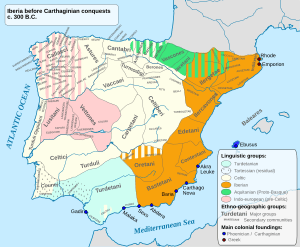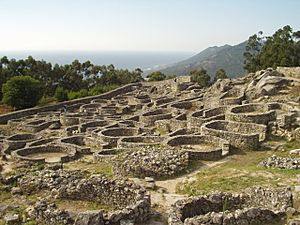Gallaeci facts for kids
The Gallaeci (pronounced Gal-lay-see) were a group of Celtic tribes. They lived in the northwest part of Iberia, which is now northern Portugal and the Spanish regions of Galicia, western Asturias, and western León. This was before and during the Roman period.
They spoke a Q-Celtic language called Gallaecian. This language was similar to Northeastern Hispano-Celtic. The Romans took over their land during the Cantabrian Wars when Caesar Augustus was emperor. This war started the process of the Gallaeci becoming more like the Romans.
The name for people from modern-day Galicia, galegos, comes directly from the Gallaeci people.
Contents
Ancient Homes and Culture
Archaeologists study the past by looking at old objects and sites. They believe the Gallaeci developed from a local culture called the Atlantic Bronze Age (around 1300–700 BC). During the Iron Age, they were influenced by other cultures. These included groups from southern Iberia, central Europe, and the Mediterranean (like the Phoenicians and Carthaginians).
The Gallaeci lived in fortified villages called hill forts. These were known as castros in their language. The archaeological culture they created is called the "Castro culture". These hill forts often had round or long houses.
The Gallaeci built their lives around these fortified settlements. They were called "castra" (hill forts) or "oppida" (citadels) by the Romans. These varied in size. Some were small villages less than one hectare (about 2.5 acres). Others were large walled citadels over 10 hectares (25 acres). The larger ones were more common in the southern areas.
Big towns were not common in Gallaecia before the Romans arrived. However, some medium-sized oppida have been found. These include Portus Calle (near Porto), Tongobriga (Freixo), Lugus (Lugo), and Brigantium (Betanzos).
Living in hill forts was common across Europe during the Bronze and Iron Ages. In northwest Iberia, this way of life became known as the "Castro culture." Many Gallaecian hill forts were still used until the 5th century AD.
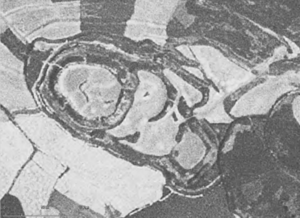
These fortified villages were usually built on hills, rocky cliffs, or peninsulas near the sea. This gave them a good view and control over their land. They were also placed strategically to control natural resources, like iron ore. Gallaecian hill forts shared many common features. However, the larger citadels sometimes had their own unique cultural styles.
Archaeologists have also found famous Gallaecian warrior statues connected to these hill forts. These statues are slightly larger than life-size. People believe they represent local heroes who were honored after death.
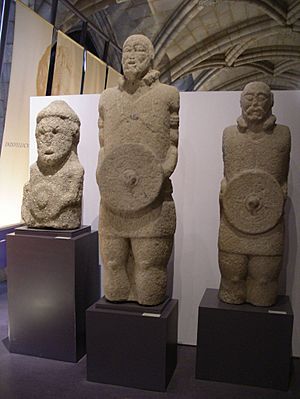
How Gallaeci Tribes Were Organized
We don't know exactly how the Gallaeci were organized politically. However, it's likely they were divided into small, independent groups called populus or civitas by the Romans. Each group was probably led by a local chief or "princeps." Each populus included many small hill forts (castellum).
So, each Gallaecian person saw themselves as part of their populus and the specific hill fort where they lived. We know this from how they wrote their names. For example, an inscription might say:
- Nicer, son of Clutosius, from Cauria, a leader of the Albions.
- Apana, daughter of Ambollus, a Supertamaric Celtic, from [-]obri.
Gallaeci Tribes List
The Gallaeci were made up of many different tribes. Here are some of the main ones:
|
Bracarenses |
Lucenses |
Other Smaller Groups
|
A Roman writer named Pomponius Mela described the Gallaecian coast around 40 AD. He said the Grovii lived in the south, while Celtic peoples lived along the Rías Baixas and Costa da Morte in northern Galicia. The Celtic Artabri lived along the northern coast.
Where the Name "Gallaeci" Came From
The Romans named the whole region north of the Douro river after the Callaeci people. This was because a group of these people lived near a place called Calle. The Romans built a port in the south of this region and called it Portus Calle. This is where the city of Porto in northern Portugal is today.
At first, the Romans ruled the Gallaeci as part of the province of Lusitania. But later, they created a new province called Callaecia or Gallaecia.
The names "Callaici" and "Calle" are the origin of modern names like Gaia, Galicia, and the "Gal" part of "Portugal." Many other place names in the region also come from these ancient names.
The Gallaecian Language
Gallaecian was a Q-Celtic language or a group of related languages. It was very similar to Celtiberian. People spoke it in the northwest part of the Iberian Peninsula. This was roughly between the Atlantic coasts and a line connecting Oviedo and Mérida.
We know about this language from words and short sentences found in old Latin inscriptions. Also, classic writers sometimes explained Gallaecian words. A lot of names—of people, tribes, gods, and places—found in inscriptions or still used today, also help us understand it. Many Celtic words found in local Romance languages might have come from these Q-Celtic dialects.
Gallaecian Gods and Goddesses
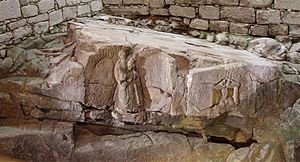
From Gallaecian-Roman inscriptions, we know about many Gallaecian gods. Some of these gods were also worshipped by other Celtic or Celtic-influenced peoples in Iberia, like the Astur and Lusitanian tribes. They were also known by Gauls and Britons. Here are some important ones:
- Bandua: This was the Gallaecian God of War, similar to the Roman god Mars. He was very popular among the Gallaeci in Braga.
- Berobreus: This god was connected to the Otherworld and the afterlife. The biggest temple for Berobreus was found at the fort of Donón (Cangas).
- Bormanicus: A god of hot springs, similar to the Gaulish god Bormanus.
- Nabia: A goddess of waters, fountains, and rivers. Many rivers in Galicia and Portugal still have names like Navia. The Idol Fountain in northern Portugal is dedicated to her.
- Cossus: A warrior god who was very popular among the southern Gallaeci. He was one of the most respected gods in ancient Gallaecia. Some think Cossus and Bandua might be the same god with different names.
- Reue: This god was linked to the highest god, justice, and also death.
- Lugus: Also called Lucubo, this god was linked to wealth, trade, and crafts. He is often shown with a spear. Lugus was common among Celts, and many places across Celtic Europe, from Galicia (Lucus in Latin) to Loudoun (Scotland), are named after him.
- Coventina: A goddess of plenty and fertility. She was strongly linked to water nymphs. Her worship has been found across Western Europe, from England to Gallaecia.
- Endovelicus (Belenus): A god of prophecy and healing. He would appear to his followers in dreams.
Gallaeci History
The Gallaeci did not start writing until they met the Romans. This makes it hard to study their early history. However, ancient Greek and Latin writers mentioned them before the Roman conquest. This helps us understand some events from the 2nd century BC. The oldest known writing about the Gallaeci was found in Turkey. It was on a monument to Augustus, mentioning them as one of the nations he conquered.
The Gallaeci lived in a mountainous area, which protected them from Carthaginian rule in the 3rd century BC. However, a group of Gallaeci and Lusitani mercenaries fought in Hannibal's army during the Second Punic War. They took part in battles like Lake Trasimene and Cannae.
In his long poem Punica, Silius Italicus described these mercenaries: Rich Gallaecia sent its young warriors. They were skilled at telling the future by looking at animal insides, feathers, and flames. They would howl barbarian songs in their own languages. They would also stamp the ground in rhythmic dances, making the ground ring, and clap their shields to the beat.
The Gallaeci first had direct contact with Rome later on. This happened after Rome fought against their southern neighbors, the Lusitani and Turduli Veteres. Gallaeci warriors were known as tough fighters. They fought for the Lusitani during Viriathus's wars in the south.
Around 138-136 BC, the Romans first entered Gallaeci territory. The Roman consul Decimus Junius Brutus led this campaign. He reached as far as the Minho river. He defeated a large Gallaeci army of 60,000 soldiers near the Douro river. In this battle, 50,000 Gallaeci were killed and 6,000 were captured.
It's not clear if the Gallaeci actively fought in the Sertorian Wars. However, a Roman record says that a Roman general captured the town of Cale around 74 BC. Later, in 61-60 BC, Julius Caesar defeated the northern Gallaeci in a battle involving both land and sea forces at Brigantium. This made them accept Roman rule, but it was mostly symbolic at first.
The real Roman conquest began with the first Astur-Cantabrian War in 29 BC. A Roman writer named Paulus Orosius briefly mentions that Roman generals fought a difficult campaign to conquer the Gallaeci tribes living in the remote, forested, and mountainous parts of Gallaecia near the Atlantic Ocean. They won after several tough battles, but no exact details are given. After conquering Gallaecia, Augustus used the land as a base to attack the Astures from behind.
Becoming Roman
In the late 1st century BC, the Romans set up military settlements. Augustus reorganized the peaceful Gallaeci tribes into the new province of Gallaecia. The city of Bracara Augusta (Braga) became its capital.
During the Roman Empire, Gallaecia became a place where the Roman Army recruited extra troops called auxilia. Gallaecian cavalry (horseback soldiers) and infantry (foot soldiers) units were known for their bravery. They fought well during Emperor Claudius's conquest of Britain in AD 43-60.
Gallaecia remained one of the last places in the Iberian Peninsula where Celtic culture and language survived. This lasted well into the Roman period, at least until Christianity spread and the Germanic invasions happened in the late 4th and early 5th centuries AD. At that time, the region was conquered by the Suevi and their allies.
See also
 In Spanish: Galaicos para niños
In Spanish: Galaicos para niños


